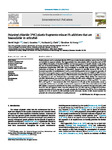Polyvinyl chloride (PVC) plastic fragments release Pb additives that are bioavailable in zebrafish
| dc.contributor.author | Boyle, D | |
| dc.contributor.author | Catarino, AI | |
| dc.contributor.author | Clark, Nathaniel | |
| dc.contributor.author | Henry, TB | |
| dc.date.accessioned | 2021-08-09T10:11:59Z | |
| dc.date.issued | 2020-08 | |
| dc.identifier.issn | 0269-7491 | |
| dc.identifier.issn | 1873-6424 | |
| dc.identifier.other | 114422 | |
| dc.identifier.uri | http://hdl.handle.net/10026.1/17417 | |
| dc.description.abstract |
Plastic polymers such as polyvinyl chloride (PVC) may contain chemical additives, such as lead (Pb), that are leachable in aqueous solution. The fragmentation into microplastics (MPs) of plastics such as PVC may facilitate desorption of chemical additives and increase exposure of aquatic animals. In this study, the role of chemical additives in the aqueous toxicity of PVC, high-density polyethylene (HDPE) and polyethylene terephthalate (PET) MPs were investigated in early-life stage zebrafish (Danio rerio) by assessment of changes in expression of biomarkers. Exposure of zebrafish larvae to PVC for 24 h increased expression of metallothionein 2 (mt2), a metal-binding protein, but no changes in expression of biomarkers of estrogenic (vtg1) or organic (cyp1a) contaminants were observed. HDPE and PET caused no changes in expression of any biomarkers. A filtered leachate of the PVC also caused a significant increase in expression of mt2 and indicated that a desorbed metal additive likely elicited the response in zebrafish. Metal release was confirmed by acid-washing the MPs which mitigated the response in mt2. Metal analysis showed Pb leached from PVC into water during exposures; at 500 mg PVC L-1 in water, 84.3 ± 8.7 μg Pb L-1 was measured after 24 h. Exposure to a Pb-salt at this concentration caused a comparable mt2 increase in zebrafish as observed in exposures to PVC. These data indicated that PVC MPs elicited a response in zebrafish but the effect was indirect and mediated through desorption of Pb from PVC into the exposure water. Data also indicated that PVC MPs may act as longer-term environmental reservoirs of Pb for exposure of aquatic animals; the Pb leached from PVC in 24 h in freshwater equated to 2.52% of total Pb in MPs leachable by the acid-wash. Studies of MPs should consider the potential role of chemical additives in toxicity observed. | |
| dc.format.extent | 114422-114422 | |
| dc.format.medium | Print-Electronic | |
| dc.language | en | |
| dc.language.iso | en | |
| dc.publisher | Elsevier | |
| dc.rights | Attribution-NonCommercial-NoDerivatives 4.0 International | |
| dc.rights | Attribution-NonCommercial-NoDerivatives 4.0 International | |
| dc.rights | Attribution-NonCommercial-NoDerivatives 4.0 International | |
| dc.rights | Attribution-NonCommercial-NoDerivatives 4.0 International | |
| dc.rights.uri | http://creativecommons.org/licenses/by-nc-nd/4.0/ | |
| dc.rights.uri | http://creativecommons.org/licenses/by-nc-nd/4.0/ | |
| dc.rights.uri | http://creativecommons.org/licenses/by-nc-nd/4.0/ | |
| dc.rights.uri | http://creativecommons.org/licenses/by-nc-nd/4.0/ | |
| dc.subject | Microplastic | |
| dc.subject | Polyvinyl chloride | |
| dc.subject | Pb | |
| dc.subject | Metallothionein | |
| dc.subject | Zebrafish | |
| dc.title | Polyvinyl chloride (PVC) plastic fragments release Pb additives that are bioavailable in zebrafish | |
| dc.type | journal-article | |
| dc.type | Journal Article | |
| plymouth.author-url | https://www.webofscience.com/api/gateway?GWVersion=2&SrcApp=PARTNER_APP&SrcAuth=LinksAMR&KeyUT=WOS:000539426400120&DestLinkType=FullRecord&DestApp=ALL_WOS&UsrCustomerID=11bb513d99f797142bcfeffcc58ea008 | |
| plymouth.issue | Pt A | |
| plymouth.volume | 263 | |
| plymouth.publication-status | Published | |
| plymouth.journal | Environmental Pollution | |
| dc.identifier.doi | 10.1016/j.envpol.2020.114422 | |
| plymouth.organisational-group | /Plymouth | |
| plymouth.organisational-group | /Plymouth/Faculty of Science and Engineering | |
| plymouth.organisational-group | /Plymouth/Faculty of Science and Engineering/School of Biological and Marine Sciences | |
| plymouth.organisational-group | /Plymouth/REF 2021 Researchers by UoA | |
| plymouth.organisational-group | /Plymouth/REF 2021 Researchers by UoA/UoA07 Earth Systems and Environmental Sciences | |
| plymouth.organisational-group | /Plymouth/Users by role | |
| plymouth.organisational-group | /Plymouth/Users by role/Academics | |
| dc.publisher.place | England | |
| dcterms.dateAccepted | 2020-03-18 | |
| dc.rights.embargodate | 2021-8-25 | |
| dc.identifier.eissn | 1873-6424 | |
| dc.rights.embargoperiod | Not known | |
| rioxxterms.versionofrecord | 10.1016/j.envpol.2020.114422 | |
| rioxxterms.licenseref.uri | http://creativecommons.org/licenses/by-nc-nd/4.0/ | |
| rioxxterms.licenseref.startdate | 2020-08 | |
| rioxxterms.type | Journal Article/Review |



